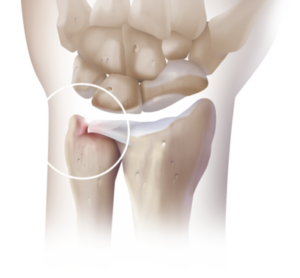The triangular fibrocartilage complex (TFCC) consists of a cartilaginous disc that lies between the ulnar and the triquetrum and lunate bones, the ulnar meniscus, the sheath of the extensor carpi ulnaris (one of the muscles responsible for extending and ulnar deviating the wrist), and several ligaments of the wrist and hand.
The complex is loaded in movements that involve axial compression in a position of ulnar deviation (i.e. punching with the hand bent slightly towards the ulnar (inside bone of the forearm). Pain in this condition is usually isolated to the ulnar side of the wrist, and is worsened with weight-bearing, rotation, gripping, and punching. Pain experienced in the hands when pushing oneself out of a chair is a tell-tale sign. In some cases, athletes may note a deep clicking with rotation of the wrist.
Less-severe TFCC injuries may be managed conservatively, initially with relative rest, bracing, taping and activity modification to allow symptoms to settle, followed by a rehabilitation programme focusing on strength and mobility around the wrist and elbow.
As only the outside of this complex is vascularised and conducive to good healing, the injury can be slow to respond to conservative management, and in these cases, torn cartilage may need to be excised. Having an ulna longer than the radius may predispose an athlete to the condition, in which case surgical management may also involve shortening of the bone. Return to full function is usually in the realm of 3 months.
Anecdotally, supplementary strength and mobility work for the wrist and elbow, particularly into pronation and supination, appears to be effective in decreasing the likelihood of TFCC injury in striking athletes.
